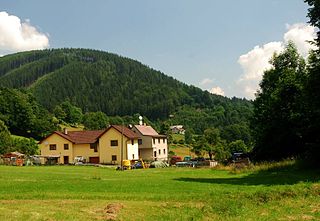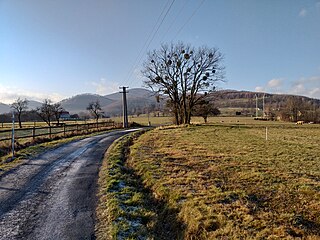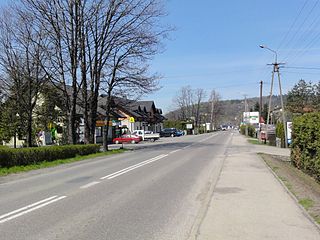
Brenna (help·info) is a village in and the seat of Gmina Brenna, Cieszyn County, Silesian Voivodeship, southern Poland, located in the historical region of Cieszyn Silesia. It is located in the Silesian Beskids mountain range, along the river Brennica, right tributary of the Vistula river.

Košařiska (help·info) is a village in Frýdek-Místek District, Moravian-Silesian Region, Czech Republic. It has a population of 365, 38.7% of the population are the Poles. The village lies in the historical region of Cieszyn Silesia and is situated on the Kopytná creek on the foothills of the Moravian-Silesian Beskids mountain range.

Lyžbice (help·info) is a part of the town of Třinec in Frýdek-Místek District, Moravian-Silesian Region, Czech Republic, on the Olza River. It was a separate municipality but later became administratively a part of the town of Třinec. It lies in the historical region of Cieszyn Silesia and has a population of 17,239.

Jaworzynka (help·info) is a village in Gmina Istebna, Cieszyn County in Silesian Voivodeship, southern Poland. The village is situated in Beskid Śląski mountain range, near to the borders with the Czech Republic and Slovakia, in the historical region of Cieszyn Silesia.

Karpentná (help·info) is a village in Frýdek-Místek District, Moravian-Silesian Region, Czech Republic. It was a separate municipality but became administratively a part of Třinec in 1980. It lies in the historical region of Cieszyn Silesia and has a population of 705.

Tyra (help·info) is a village in Frýdek-Místek District, Moravian-Silesian Region, Czech Republic. It was a separate municipality but became administratively a part of Třinec in 1980. Tyrka flows through the village. It has a population of 445 and lies in the historical region of Cieszyn Silesia.

Górki Małe (help·info) is a village in Gmina Brenna, Cieszyn County, Silesian Voivodeship, southern Poland. It has a population of 768 (2008). It lies in the historical region of Cieszyn Silesia.

Gumna is a village in Gmina Dębowiec, Cieszyn County, Silesian Voivodeship, southern Poland. It has a population of 414 (2004).

Zbytków is a village in Gmina Strumień, Cieszyn County, Silesian Voivodeship, southern Poland. It has a population of 1,262. It lies in the historical region of Cieszyn Silesia.

Bąków is a village in Gmina Strumień, Cieszyn County, Silesian Voivodeship, southern Poland. It has a population of 1,534 (2008). It lies in the historical region of Cieszyn Silesia. Former village of Rychułd is now a western part of Bąków.

Zabłocie is a village in Gmina Strumień, Cieszyn County, Silesian Voivodeship, southern Poland. It has a population of 1,312 (2008) and an area of 19,03 km2. It lies in the historical region of Cieszyn Silesia.

Pierściec is a village in Gmina Skoczów, Cieszyn County, Silesian Voivodeship, southern Poland. It has a population of about 1,918. It lies in the historical region of Cieszyn Silesia.

Kiczyce is a village in Gmina Skoczów, Cieszyn County, Silesian Voivodeship, southern Poland. It has a population of about 1127 and lies in the historical region of Cieszyn Silesia.

Kowale is a village in Gmina Skoczów, Cieszyn County, Silesian Voivodeship, southern Poland. It has a population of about 610 and lies in the historical region of Cieszyn Silesia.

Mnich is a village in Gmina Chybie, Cieszyn County, Silesian Voivodeship, southern Poland. It has a population of 3,569 (2008). It lies in the historical region of Cieszyn Silesia.

Landek is a village in Gmina Jasienica, Bielsko County, Silesian Voivodeship, southern Poland. It has a population of 601 (2016). Landek lies in the historical region of Cieszyn Silesia.

Wieszczęta is a village in Gmina Jasienica, Bielsko County, Silesian Voivodeship, southern Poland. It has a population of 529 (2016). It lies in the Silesian Foothills and in the historical region of Cieszyn Silesia.

Łazy is a village in Gmina Jasienica, Bielsko County, Silesian Voivodeship, southern Poland. It has a population of 903 (2016). It lies in the Silesian Foothills and in the historical region of Cieszyn Silesia.

Bronów is a village in Gmina Czechowice-Dziedzice, Bielsko County, Silesian Voivodeship, southern Poland. It has a population of 1,027 (2008). The village lies on the edge of the historical region of Cieszyn Silesia.

Mnisztwo is a district of Cieszyn, Silesian Voivodeship, Poland. It was a separate municipality, but became administratively a part of Cieszyn in 1973.





















